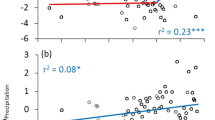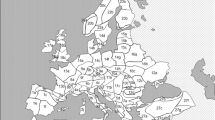Abstract
The distributional expansion of the ladybird beetle Cheilomenes sexmaculata (Fabricius) in Japan was analyzed based on literature surveys and observations of 1,312 individual specimens collected from 1918 to 2005. An expansion toward higher latitudes, from Kyushu (33°N) to central Honshu (36°N), was observed between 1910 and the early 1990s. Multiple regression analysis showed that the presence of this beetle was associated with an annual mean temperature but not with the mean minimum temperature in the coldest month, and 95 % occurrence probability of this beetle was obtained in a locality at 15.1 °C annual mean temperature. The northward expansion of this species synchronizes with increasing areas where an annual mean temperature is more than 15 °C. Therefore, climatic warming over the past 100 years is considered as a major factor influencing the northward expansion of this species.



Similar content being viewed by others
References
Campbell A, Frazer BD, Gilbert N, Gutierrez AP, MacKauer M (1974) Temperature requirements of some aphids and their parasites. J Appl Ecol 11:431–438
Crozier L (2003) Winter warming facilitates range expansion: cold tolerance of the butterfly Atalopedes campestris. Oecologia 135:648–656
Emura K (2002) The distribution extension of Lepidoptera in Kanto district. Nat Insects 37:16–20 (in Japanese)
Fujita F (1985) Beetles around Urawa City. (1) Coccinellidae. Nat Insects 20:28–31 (in Japanese)
Gunma Prefecture (2011) Coccinellidae. In: Gunma Museum of Natural History (ed) Animal research in the Higashiazuma-cho of Naganohara area: natural history research report V. Gunma Museum of Natural History, Gunma, pp 33–34 (in Japanese)
Hodek I, Honék A (1996) Ecology of Coccinellidae. Kluwer, London
Hozumi T (1974) Beetle of the Tokai area (20). Kakocho 26:105–116 (in Japanese)
Hukusima S, Kouyama S (1974) Life histories and food habits of Menochilus sexmaculatus Fabricius (Coleoptera: Coccinellidae). Res Bull Fac Agric Gifu Univ 36:19–29
Ishikawa Prefecture (1979) III Insects. In: Ishikawa environment section (ed) Natural environment research report of Noto-uchiura. Ishikawa Prefecture, Ishikawa, pp 31–38 (in Japanese)
Ishikawa Prefecture (1980) II Insects. In: Ishikawa environment section (ed) Natural environment research report of Noto-sotoura. Ishikawa Prefecture, Ishikawa, pp 43–46 (in Japanese)
Ishikawa Prefecture (1982) III Insects. In: Ishikawa Hakusan nature conservation center (ed) Natural environment research report and environment conservation measures of Ozogawa river areas. Ishikawa Prefecture, Ishikawa, pp 55–59 (in Japanese)
Ishikawa Prefecture (1994) VI Insect fauna of slash-and-burn fields. In: Ishikawa Hakusan nature conservation center (ed) Research report of Hakusan-yakihata areas. Ishikawa Prefecture, Ishikawa, pp 59–75 (in Japanese)
Ishikawa Prefecture (1998) Coccinellidae. In: Ishikawa mushino-kai, Hyakumangoku-cho-danwakai (eds) Insects of Ishikawa Prefecture. Ishikawa Prefcture, Ishikawa, pp 180–183 (in Japanese)
Kamitani S, Yata O (2002) Prediction of distributional expansion of Junonia almanac by global warming. Nat Insects 37:8–11 (in Japanese)
Kiritani K (1997) The low developmental threshold temperature and the thermal constant in insects, mites and nematodes in Japan. Mis Pub Natn Inst Agro-Environ Sci 21:1–72 (in Japanese with English summary)
Kiritani K (2006) Predicting impacts of global warming on population dynamics and distribution of arthropods in Japan. Popul Ecol 48:5–12
Kiritani K (2012) The low development threshold temperature and the thermal constant in insects and mites in Japan (2nd edition). Bull Natl Inst Agro-Environ Sci 31:1–74 (in Japanese with English summary)
Kishi K (2001) Change in the distribution of the great mormon butterfly, Papilio memnon in Kanagawa Prefecture. Gekkan-Mushi 364:34–35 (in Japanese)
Kobayashi M, Nihei N, Kurihara T (2002) Analysis of northern distribution of Aedes albopictus (Diptera: Culicidae) in Japan by geographical information system. J Med Entomol 39:4–11
Laponite SL, Borchert DM, Hall DG (2007) Effect of low temperatures on mortality and oviposition in conjunction with climate mapping to predict spread of the root weevil Diaprepes abbreviatus and introduced natural enemies. Environ Entomol 36:73–82
Liu YC, Kuo MH, Yang SC (2000) Biology and rearing by use of alternative food of the ladybird beetle, Cheilomenes sexmaculata Fabricius. Plant Prot Bull Taipei 42:11–23
Matsumoto City (1997) Coccinellidae. In: Editing committee of natural section in the Matsumoto City history (ed) Insects of Matsumoto city natural section surveys I. Matsumoto City, Matsumoto, pp 52–53 (in Japanese)
Muikamachi (1981) Coleoptera. In: Muikamachi (ed) Nature of Muikamachi–Nishiyama. Muikamachi, Niigata, pp 290–311 (in Japanese)
Naito A, Hattori I, Igarashi R (1971) Distribution and occurrence of Spodoptera litura in Japan. Shokubutuboeki 25:475–479 (in Japanese)
Ohkawa H (1994) Beetles of the Watarase river bottomland and its habitat classification, Central Japan. Mem Tochigi Pref Mus 12:35–64 (in Japanese)
Ohmomo S (1991) Coccinellidae of Ibaraki Prefecture. Ruriboshi 16:5–14 (in Japanese)
Sakurai S (2001) Coccinellidae. In: Sakurai S (ed) Insects of Matsuyama-cho. Sakata City, Yamagata, pp 15–30 (in Japanese)
Sakurai S, Okabe K (2003) Coccinellidae. In: Sakurai S, Okabe K (eds) A list of insect from Sakata City. Sakata City, Yamagata, pp 108–110 (in Japanese)
SAS Institute (2009) JMP user’s guide, release 8. SAS Institute, Cary
Sasaji H (1971) Genus Menochilus Timberlake. In: Sasaji H (ed) Fauna Japonica: Coccinellidae. Academic Press of Japan, Tokyo, pp 284–286
Sasaji H (1998) The heredity and the problems of elytral color polymorphism in Cheilomenes sexmaculata (Coleoptera: Coccinellidae). Natural History of the Ladybirds. University of Tokyo Press, Tokyo, pp 168–175 (in Japanese)
Sato K (1981) The list of in Kanagawa prefecture. In: Social education department of Kanagawa Prefecture (ed) Insects surveys of Kanagawa Prefecture. Kanagawa education board, Kanagawa, pp 413–416 (in Japanese)
Suwa T (2003) The check list of the distributions of butterflies in Shizuoka Prefecture based on records published in Suruga no Konchu. Shizuoka Koncyu Dokokai, Shizuoka, pp 1368 (In Japanese)
Takizawa M (1917) Some new species of Coccinellidae in Japan. I. Trans Sapporo Nat Hist Soc 6:220–224
Tanaka H, Sasaji H (1992) Karyotypes of 27 species Coccinellidae from Fukui Prefecture. Fukui Chuho 11:25–38 (in Japanese)
Tochigi Prefecture (2000) Coleoptera. In: Tochigi Prefectural museum (ed) Flora and Fauna of Nasu imperial villa. Tochigi Prefectural museum, Tochigi, pp 103–134 (in Japanese)
Tochigi Prefecture (2003) Coccinellidae. In: Insects affiliated society of the natural environments surveys of Tochigi Prefecture (ed) Insects of Tochigi prefecture II. Natural environments surveys of Tochigi prefecture. Forestry section of Tochigi prefecture, Tochigi, pp 276–286 (in Japanese)
Tougou D, Musolin DL, Fujisaki K (2009) Some like it hot! Rapid climate change promotes changes in distribution ranges of Nezara viridula and Nezara antennata in Japan. Entomol Exp Applic 130:249–258
Toyama City (1994) Coccinellidae. In: Science and culture center of Toyama City (ed) Natural environments surveys of Kureha-kyuryo in Toyama City. Toyama City, Toyama, pp 138–139 (in Japanese)
Toyama City (1996) Coccinellidae. In: Science and culture center of Toyama City (ed) Natural environments surveys of the river Joganji basin. Toyama City, Toyama, pp 195–196 (in Japanese)
Toyama City (1998) Coccinellidae. In: Family park public corporation of Toyama City (ed) Natural environments surveys of Family park. Toyama City, Toyama, pp 103–104 (in Japanese)
Toyama Prefecture (1979) Coccinellidae. In: Toyama entomological research (ed) Insects of Toyama prefecture. Toyama Prefecture, Toyama, pp 379–382 (in Japanese)
Tran JK, Ylioja T, Billings RF, Régnière J, Ayres MP (2007) Impact of minimum winter temperatures on the population dynamics of Dendroctonus frontalis. Ecol Appl 17:882–899
Tsurugi-cho (1995) XIX. Coleoptera. In: The Tsurugi-cho Education Board (ed) Insects fauna of Tsurugi-cho. The Tsurugi-cho Education Board, Ishikawa, pp 62–76 (in Japanese)
Yamazaki H (1986) Coleoptera II. In: Numata M (ed) The list in objective collection of Natural History Museum and Institute, Chiba. The Chiba Education Board, Chiba, pp 58–91 (in Japanese)
Yonezawa City (1994) VII. Coleoptera. In: Yonezawa Uesugi cultural assets promotion foundation (ed) Insects of Azumayama. Yonezawa City Uesugi Museum, Yamagata, pp 74–85 (in Japanese)
Yoshio M, Ishii M (2004) Relationship between cold hardiness and northward invasion in the great mormon butterfly, Papilio memnon L. (Lepidoptera: Papilionidae) in Japan. Appl Entomol Zool 36:329–335
Yukawa J, Kiritani K, Gyotoku N, Uechi N, Yamaguchi D, Kamitani S (2007) Distribution range shift of two allied species, Nezara viridula and N. antennata (Hemiptera: Pentatomidae), in Japan, possibly due to global warming. Appl Entomol Zool 42:205–215
Acknowledgments
We thank Dr. K. Araya (Kyushu University), Dr. T. Tanabe (Kumamoto University), Dr. M. Hasegawa (Osaka Museum of Natural History), and Dr. M. Yokogawa (Osaka Museum of Natural History) who provided helpful discussions. We would also like to express our special thanks to Dr. S. Nomura (National Museum of Nature and Science), Dr. Y. Sawada (Museum of Nature and Human Activities Hyogo), Mr. R. Matsumoto (Osaka Museum of Natural History), Dr. Y. Okushima (Kurashiki Museum of Natural History), Prof. M. Sakai (Ehime University), Mr. K. Kishimoto (Ehime University), Prof. H. Kojima (Tokyo University of Agriculture), and Mr. D. Yamaguchi (Kyushu University) for their help in studying the museum specimens, as well as Mr. Y. Matsubara (Yokohama City) and Mr. Y. Hirano (Odawara City) for allowing us to examine their private C. sexmaculata collections.
Author information
Authors and Affiliations
Corresponding author
Rights and permissions
About this article
Cite this article
Kawakami, Y., Yamazaki, K. & Ohashi, K. Northward expansion and climatic factors affecting the distribution limits of Cheilomenes sexmaculata (Coleoptera: Coccinellidae) in Japan. Appl Entomol Zool 49, 59–66 (2014). https://doi.org/10.1007/s13355-013-0224-0
Received:
Accepted:
Published:
Issue Date:
DOI: https://doi.org/10.1007/s13355-013-0224-0




